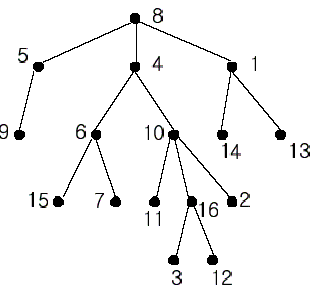Nearest Common Ancestors
Description
A rooted tree is a well-known data structure in computer science and engineering. An example is shown below:

In the figure, each node is labeled with an integer from {1, 2,...,16}. Node 8 is the root of the tree. Node x is an ancestor of node y if node x is in the path between the root and node y. For example, node 4 is an ancestor of node 16. Node 10 is also an ancestor of node 16. As a matter of fact, nodes 8, 4, 10, and 16 are the ancestors of node 16. Remember that a node is an ancestor of itself. Nodes 8, 4, 6, and 7 are the ancestors of node 7. A node x is called a common ancestor of two different nodes y and z if node x is an ancestor of node y and an ancestor of node z. Thus, nodes 8 and 4 are the common ancestors of nodes 16 and 7. A node x is called the nearest common ancestor of nodes y and z if x is a common ancestor of y and z and nearest to y and z among their common ancestors. Hence, the nearest common ancestor of nodes 16 and 7 is node 4. Node 4 is nearer to nodes 16 and 7 than node 8 is.
For other examples, the nearest common ancestor of nodes 2 and 3 is node 10, the nearest common ancestor of nodes 6 and 13 is node 8, and the nearest common ancestor of nodes 4 and 12 is node 4. In the last example, if y is an ancestor of z, then the nearest common ancestor of y and z is y.
Write a program that finds the nearest common ancestor of two distinct nodes in a tree.

In the figure, each node is labeled with an integer from {1, 2,...,16}. Node 8 is the root of the tree. Node x is an ancestor of node y if node x is in the path between the root and node y. For example, node 4 is an ancestor of node 16. Node 10 is also an ancestor of node 16. As a matter of fact, nodes 8, 4, 10, and 16 are the ancestors of node 16. Remember that a node is an ancestor of itself. Nodes 8, 4, 6, and 7 are the ancestors of node 7. A node x is called a common ancestor of two different nodes y and z if node x is an ancestor of node y and an ancestor of node z. Thus, nodes 8 and 4 are the common ancestors of nodes 16 and 7. A node x is called the nearest common ancestor of nodes y and z if x is a common ancestor of y and z and nearest to y and z among their common ancestors. Hence, the nearest common ancestor of nodes 16 and 7 is node 4. Node 4 is nearer to nodes 16 and 7 than node 8 is.
For other examples, the nearest common ancestor of nodes 2 and 3 is node 10, the nearest common ancestor of nodes 6 and 13 is node 8, and the nearest common ancestor of nodes 4 and 12 is node 4. In the last example, if y is an ancestor of z, then the nearest common ancestor of y and z is y.
Write a program that finds the nearest common ancestor of two distinct nodes in a tree.
Input
The input consists of T test cases. The number of test cases (T) is given in the first line of the input file. Each test case starts with a line containing an integer N , the number of nodes in a tree, 2<=N<=10,000. The nodes are labeled with integers 1, 2,..., N. Each of the next N -1 lines contains a pair of integers that represent an edge --the first integer is the parent node of the second integer. Note that a tree with N nodes has exactly N - 1 edges. The last line of each test case contains two distinct integers whose nearest common ancestor is to be computed.
Output
Print exactly one line for each test case. The line should contain the integer that is the nearest common ancestor.
Sample Input
2 16 1 14 8 5 10 16 5 9 4 6 8 4 4 10 1 13 6 15 10 11 6 7 10 2 16 3 8 1 16 12 16 7 5 2 3 3 4 3 1 1 5 3 5
Sample Output
4 3
题意:n组数据,y-1条边,最后一个求lca;
博客:http://blog.csdn.net/barry283049/article/details/45842247;我的代码思路根据最后的在线算法得出;

#include<iostream> #include<cstdio> #include<cmath> #include<string> #include<queue> #include<algorithm> #include<stack> #include<cstring> #include<vector> #include<list> #include<set> #include<map> using namespace std; #define ll long long #define mod 1000000007 #define inf 999999999 //#pragma comment(linker, "/STACK:102400000,102400000") int scan() { int res = 0 , ch ; while( !( ( ch = getchar() ) >= '0' && ch <= '9' ) ) { if( ch == EOF ) return 1 << 30 ; } res = ch - '0' ; while( ( ch = getchar() ) >= '0' && ch <= '9' ) res = res * 10 + ( ch - '0' ) ; return res ; } struct is { int u,v; int next; }edge[20010]; int head[20010]; int deep[20010]; int rudu[20100]; int first[20010]; int dfn[20010];//存深搜的数组 int dp[20010][30]; int point,jiedge; int minn(int x,int y) { return deep[x]<=deep[y]?x:y; } void update(int u,int v) { jiedge++; edge[jiedge].u=u; edge[jiedge].v=v; edge[jiedge].next=head[u]; head[u]=jiedge; } void dfs(int u,int step) { dfn[++point]=u; deep[point]=step; if(!first[u]) first[u]=point; for(int i=head[u];i;i=edge[i].next) { int v=edge[i].v; dfs(v,step+1); dfn[++point]=u; deep[point]=step; } } void st(int len) { for(int i=1;i<=len;i++) dp[i][0]=i; for(int j=1;(1<<j)<=len;j++) for(int i=1;i+(1<<j)-1<=len;i++) { dp[i][j]=minn(dp[i][j-1],dp[i+(1<<(j-1))][j-1]); } } int query(int l,int r) { int lll=first[l]; int rr=first[r]; if(lll>rr) swap(lll,rr); int x=(int)(log((double)(rr-lll+1))/log(2.0)); return dfn[minn(dp[lll][x],dp[rr-(1<<x)+1][x])]; } int main() { int x,y,z,i,t; scanf("%d",&x); while(x--) { memset(head,0,sizeof(head)); memset(rudu,0,sizeof(rudu)); memset(first,0,sizeof(first)); point=0; jiedge=0; scanf("%d",&y); for(i=1;i<y;i++) { int u,v; scanf("%d%d",&u,&v); update(u,v); rudu[v]++; } for(i=1;i<=y;i++) if(!rudu[i]) { dfs(i,0); break; } st(point); int u,v; scanf("%d%d",&u,&v); printf("%d ",query(u,v)); } return 0; }
